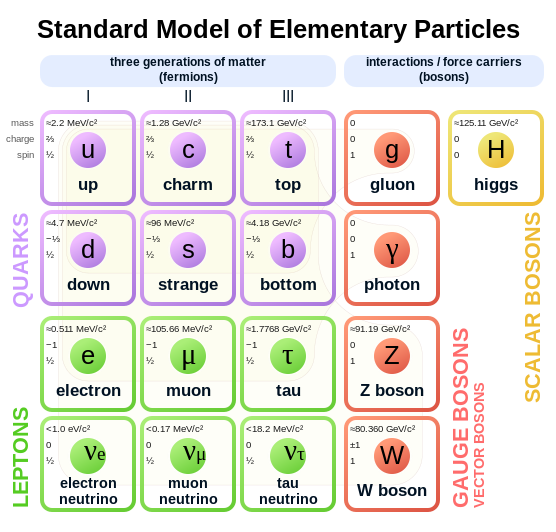But what is this Higgs boson, what does it do and why didn't we see it before?
The mystery of the massive particles
When physicists were deriving the physics of elementary particles, they used certain assumptions about the universe, most of them are related to symmetries. What's a symmetry? Take for example rotational symmetry. Imagine you are standing in the middle of a round football stadium. It does not matter if you rotate, you will still see the same image. There is a very fancy theorem that says that every symmetry has an accompanied conserved quantity. The rotational symmetry, for example, yields conservation of angular momentum, whereas translational symmetry in time (meaning physics looks the same now and 10 minutes from now) yield conservation of energy.
Using some more advaced symmetry groups all of our beloved standard particles can be found:
The standard model (without Higgs)
The group in red are called gauge bosons. They are resultants of a very special symmetry and they can be interpreted as forces working on all the other particles. In fact, every elementary force has a matching gague boson. The photon (symbolised with a gamma), or "light", transfers electromagnetic forces, the gluon the strong force and Z and W the weak force.
But there is a problem. The theory requires the W and Z boson to be massless in order for the theory to work. This is obviously not the case, because these particles have been found to have mass. In fact, they are pretty heavy!
The Higgs mechanism
When physicist discovered that the theory was in trouble, they started searching for solutions. The symmetry of nature that can be used to find the gauge bosons worked far too good to just abandon it. Then, a new idea rose: we keep the symmetry, but we say nature broke it spontaneously. Wait, what?
How does this work? Imagine you have a piece of plastic between your fingers and you apply a little pressure to it. Initially, the plastic stick is straight, even when you apply a little pressure to it. Now the system (nature) has a symmetry: there is for example rotational symmetry if you are standing at the position of the rod (if you ignore the hand).
But remember the hand was applying a force? This means that the stick could spontaneously jump to either the left or the right, as can be seen in the picture (try this at home ;) ). Now the symmetry that nature had is broken, spontaneously and without external help. Note that in the analogy, the hand should be seen as an initial energy that the universe has.
Spontaneous symmetry breaking
A similar scenario this of a toy car that is sitting on a small mountain, but it has some energy which makes the car shift a little. Given enough time, the car will roll off the mountain into a valley, where it will remain.
 |
| Imagine a toy car in this figure |
Now, it turns out that breaking this symmetry can be done by introducing a particle: the Higgs particle. When analysing the properties of this particle, it turns out that this particle interacts with all the other particles, including itself! Due to these interactions, the particles gain mass.
Why did this take so long to find?
Well, we didn't know where to look. Basically, in the LHC particles are shot at eachother with incredible speeds, and thus incredibly high energies. Since E=mc^2, it takes very high energies to create particles with high mass. The problem is, we don't know the mass of the Higgs, it is a free parameter of the theory. This means the mass is not predicted by the theory. And because of that, the whole LHC range has to be explored (with no guarantee that the Higgs boson is actually in this range).
Complications arise due to the fact the Higgs particle decays intoa lot of other particles very, very quickly. So we can actually only see the remnants of the Higgs particle. When there is enough energy to create a Higgs, we'd expect to see more of these remnants: a peak in a graph.
Today, the people at CERN announced that the peaks they found in many expirements, are trustworthy enough to say that the Higgs particle has been found at about 126 GeV. This is great news, because now we can confidently continue the search for theories that expand the standard model, like supersymmetry and other theories that may introduce gravity into the picture.
We aren't quite there yet, but a theory of everything is coming!


No comments:
Post a Comment